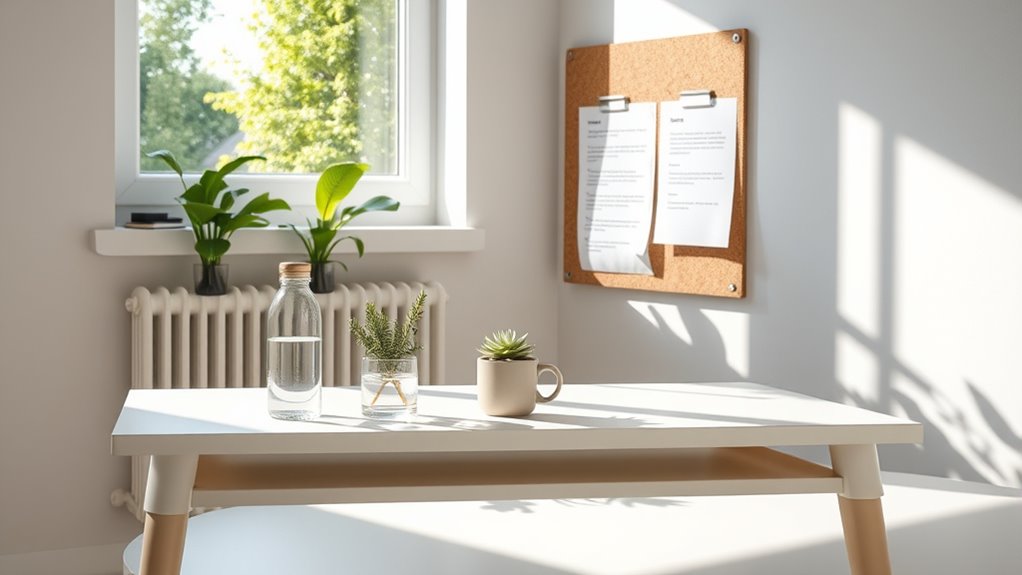Adopting a minimalist lifestyle helps you reduce your environmental footprint by cutting down on unnecessary consumption and waste. Choose eco-friendly brands, focus on quality over quantity, and incorporate sustainable habits like using reusable items and conserving energy. Repair and repurpose your belongings to extend their lifespan. Living simply not only benefits the planet but also creates a calmer, more organized life. Keep exploring to discover practical tips that make your journey toward greener living even easier.
Key Takeaways
- Prioritize quality, durable products and buy secondhand to reduce waste and promote sustainable consumption.
- Use reusable items like bags, bottles, and containers to minimize single-use plastics.
- Choose eco-friendly brands that utilize recycled materials and ethical manufacturing practices.
- Incorporate eco-conscious habits such as composting, recycling, and energy-efficient lighting into daily routines.
- Embrace minimalism to create an organized, peaceful space that supports environmental stewardship and resource mindfulness.

Adopting a minimalist lifestyle can substantially reduce your environmental impact while simplifying your life. When you focus on owning less, you naturally develop eco friendly habits that benefit both the planet and your well-being. For example, by decluttering your space, you minimize waste and reduce the need for frequent replacements. This shift encourages you to prioritize quality over quantity, which aligns perfectly with sustainable shopping. Instead of impulsively buying cheap, disposable items, you learn to choose durable, ethically made products that last longer and have a lower environmental footprint.
Sustainable shopping becomes a cornerstone of your minimalist approach. You begin to research brands that prioritize eco-friendly practices, such as using recycled materials or minimizing packaging waste. Shopping consciously means avoiding fast fashion and opting for secondhand stores, local artisans, or thrift shops. These choices not only cut down on waste but also support sustainable economies. You learn to ask questions: Where is this product made? Was it produced ethically? Can I repair or repurpose it if it breaks? These questions help you make smarter, greener decisions and avoid contributing to the cycle of overconsumption.
Incorporating eco friendly habits into your daily routine is easier than you might think. Simple actions, like using reusable bags, bottles, and containers, help cut down on single-use plastics. You can also switch to energy-efficient appliances and LED lighting to reduce your carbon footprint. Composting food scraps and recycling diligently further minimizes waste. By making these small adjustments, you create a lifestyle that honors the environment without sacrificing comfort or convenience.
Living with less also means you become more mindful of your consumption habits. You start to see items not just as objects to buy but as resources to manage responsibly. This mindset encourages you to repair and repurpose instead of discarding. When you do need new items, you seek out eco-friendly options that align with your values. Over time, these habits become second nature, fostering a more sustainable and fulfilling way of living.
Ultimately, embracing minimalism doesn’t mean giving up the things you love; it means making thoughtful choices that respect the planet. By cultivating eco friendly habits and practicing sustainable shopping, you reduce your ecological footprint while creating a calm, organized space. The result is a lifestyle that’s not only simpler but also more aligned with your values—one that supports a healthier planet for future generations.
Frequently Asked Questions
How Can Minimalism Reduce My Carbon Footprint Effectively?
By embracing minimalism, you can markedly reduce your carbon footprint. Focus on cutting excess consumption and choosing sustainable options. You can also support renewable energy projects and participate in carbon offsetting to balance out your remaining emissions. Simplifying your lifestyle means less energy use, fewer waste products, and a smaller environmental impact overall. This conscious approach helps you live more sustainably while actively contributing to a greener planet.
What Are the Best Sustainable Materials for Minimalist Living?
You can choose sustainable fabrics like organic cotton, hemp, or linen for your minimalist wardrobe, as they’re eco-friendly and durable. Opt for furniture made from recycled or responsibly sourced materials, and select eco-friendly packaging for your purchases. These choices help reduce waste and minimize your environmental impact, making your minimalist lifestyle more sustainable. Prioritizing these materials guarantees you live simply while supporting eco-conscious practices.
Can Minimalism Help in Reducing Household Waste Significantly?
Imagine transforming your home into a waste-free haven—minimalism makes that possible. By embracing clutter organization and focusing on aesthetic simplicity, you drastically cut down on unnecessary items, reducing household waste to almost zero. Every item you keep serves a purpose, and you become more mindful of what you consume. This way, you not only declutter your space but also help protect the environment, making your lifestyle truly sustainable.
How Do I Balance Minimalism With Family Needs?
Balancing minimalism with family needs requires open family communication and emotional balance. You should involve your family in decision-making, listening to their preferences and concerns. Prioritize essentials while respecting everyone’s comfort and emotions. By fostering understanding and compromise, you create a supportive environment. This approach helps you maintain a minimalist lifestyle without sacrificing family happiness, ensuring everyone’s needs are met while embracing simplicity.
Are There Eco-Friendly Minimalist Products Readily Available?
Studies show eco-friendly minimalist products are increasingly accessible. You’ll find sustainable fashion brands offering timeless pieces designed to last, reducing waste. Look for products with eco-friendly packaging that minimizes plastic and energy use. Many companies now prioritize sustainability, so you can shop consciously without sacrificing quality. By choosing these options, you support a greener lifestyle that aligns with minimalism, making it easier to live simply and sustainably.
Conclusion
Embracing a greener lifestyle is like tending a delicate garden—you nurture it with care, patience, and intention. Every small step you take, from reducing waste to choosing sustainable options, is a seed that blossoms into a healthier planet. Remember, your efforts are the roots that support a brighter, more vibrant future. Stay committed, and watch your mindful choices grow into a beautiful, enduring legacy for generations to come.









